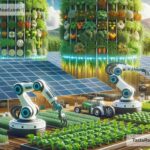The Future of Plant Breeding Techniques: Shaping Tomorrow’s Agriculture
Plant breeding has been a cornerstone of agriculture for centuries, helping farmers grow healthier, stronger, and more productive crops. By selecting seeds from the best plants and planting them again, humans have improved food supply over time. However, as the world faces challenges like climate change, growing populations, and the need for sustainable agriculture, these traditional methods alone might not be enough. Thanks to modern science and technology, plant breeding is advancing in ways that were unimaginable just a few decades ago. In this article, we’ll explore the future of plant breeding and how it could transform agriculture in the years to come.
Why Plant Breeding Is So Important
Before we dive into the future, let’s briefly talk about why plant breeding matters. Crop plants provide essential food for humans and animals, and they play a big role in global ecosystems. Plant breeding allows scientists to improve crops by making them:
- Resilient to stress: Plants that can survive droughts, floods, and extreme heat are essential in a world affected by climate change.
- High-yielding: More crops per harvest can help feed a growing population.
- Pest- and disease-resistant: Reducing reliance on chemical pesticides is better for the environment and human health.
- Nutritional: Crops can be bred to have more vitamins and minerals, helping to fight malnutrition.
Using advanced techniques, scientists are now addressing these challenges faster and more precisely than ever before.
The Rise of Modern Plant Breeding Techniques
For hundreds of years, traditional plant breeding involved crossing plants and selecting desirable traits over generations. While this process worked, it was slow and relied on chance. Thanks to innovations in science, the future of plant breeding includes tools that speed up the process and offer greater control. Here are some of the most exciting new techniques:
1. Genetic Modification (GM)
Genetic modification has been around for a few decades, and it’s already changed agriculture. GM technology involves adding or tweaking genes in plants to improve their traits. For example:
- Scientists have created corn and soybeans that resist pests, meaning farmers use fewer harmful pesticides.
- GM crops like golden rice contain extra vitamin A to help reduce malnutrition in regions where rice is a staple food.
While GM crops are effective, they’ve sparked debates about safety and environmental impact. As technology improves, these concerns are being addressed through rigorous testing and regulations.
2. Gene Editing (CRISPR)
If GM crops seemed like a leap forward, gene editing is even more revolutionary. CRISPR is a powerful tool that allows scientists to precisely “edit” a plant’s DNA, much like fixing a typo in a document. This method is faster, cheaper, and more accurate than traditional GM techniques. What makes CRISPR exciting is that scientists can enhance plants without introducing foreign genes, which might reduce public concern over genetically altered food.
For example, researchers are using CRISPR to create wheat varieties that are resistant to diseases or bananas that are less prone to spoiling. The possibilities are endless, and the technology is expected to make a big impact in the next few years.
3. Speed Breeding
Imagine being able to develop a new crop variety in one or two years instead of ten. Speed breeding is a technique that uses controlled environments (like greenhouses with LED lights) to accelerate plant growth and reproduction. This method allows researchers to produce multiple generations of plants in record time. Speed breeding has already been used to improve wheat and barley, and it’s quickly gaining momentum in the field of agriculture.
4. Artificial Intelligence (AI) and Big Data
In the age of digital technology, AI and big data are playing a growing role in plant breeding. Farmers and scientists now use sensors, drones, and computer models to gather information about crops—such as how they respond to different soil types, water levels, and weather conditions. This data can be analyzed to predict which traits could improve crop performance.
AI can also help scientists design experiments and guide breeding decisions. Instead of guessing which plants to crossbreed, AI can identify gene combinations likely to produce the best results. This makes the entire process more efficient and cost-effective.
5. Epigenetics
Epigenetics is an emerging area of science that studies how environmental factors can change how genes work—without changing the DNA itself. Scientists are learning how to manipulate these changes to develop traits like drought tolerance or faster growth in crops. Epigenetics opens up new ways to breed plants without altering their genetic code, which could address concerns that some people have about genetic engineering.
A Sustainable Future for Agriculture
The future of plant breeding isn’t just about creating stronger crops; it’s about doing so in a sustainable way. Techniques like gene editing and AI can reduce the need for chemical fertilizers and pesticides, lower water usage, and increase crop diversity. The goal is to balance food production with preserving the environment and ensuring farmer livelihoods.
In addition, these innovations can help make agriculture more inclusive. Scientists can develop crops suited to specific regions, helping small-scale farmers adapt to local challenges. For example, drought-resistant millet could improve food security in dry regions, while salt-tolerant rice could help farmers in areas with rising sea levels.
Conclusion
The future of plant breeding techniques is bright and full of opportunities. With tools like CRISPR, speed breeding, and AI, scientists are unlocking the potential to transform agriculture and address global challenges. As these technologies continue to evolve, the focus will be on creating crops that are not only more productive but also more sustainable and nutritious. The ultimate goal is to ensure that everyone—no matter where they live—has access to safe, healthy, and plentiful food. The road ahead may be challenging, but the combination of science, technology, and innovation makes it an exciting time for plant breeding.


